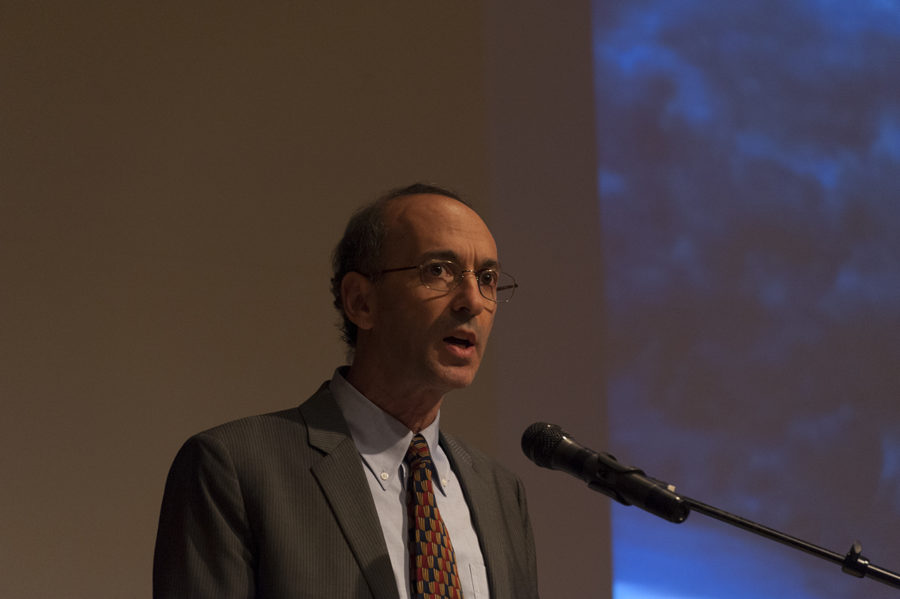Lecturer discusses human responses to climate suffering
Photo: Yanhua Huang/ Iowa State
Paul Wapner gives a lecture concerning climate change on Feb. 12 in the Sun Room of the Memorial Union.
February 13, 2013
Paul Wapner, professor of global environmental politics at American University, gave a lecture on climate suffering, focusing on human response Feb. 12 in the Sun Room of the Memorial Union.
Wapner explained that when it comes to climate change there are many challenges including civilization, technological, political and economic. He added that there was also a socio-psychological problem, which was the resistance to change.
When it came to climate change, Wapner’s thesis stated, “A major challenge to addressing change is our reluctance to embrace change itself.”
There are a few ways humans respond to climate change. Wapner said the main response is mitigation.
“Mitigation is the effort to basically reduce and ultimately stop the emission of greenhouse gases into the atmosphere, a fundamental challenge,” Wapner said.
Mitigation is stopping what humans do to emit carbon, which Wapner said can be difficult because humans put approximately 34 billion tons of carbon dioxide into the climate.
Mitigation became popular in 1988 when Jim Hanson spoke in front of congress about climate suffrage. Wapner credited Hanson for beginning the popularization of climate change.
However, only using mitigation is inefficient according Wapner.
“It seems like every time we made a commitment, emissions almost went in the opposite direction,” Wapner said.
The next response to climate suffering, Wapner explained, is adaptation, which has to do with adjusting to the climate in order to become less vulnerable.
Some examples he gave were sea walls, drought resistant agriculture, and varying electrical lines. The attempt of adaptation is trying to mitigate, but realizing that we won’t get there soon so it’s essential to adapt.
“What I want to suggest is that adaptation and mitigation are important strategies but they are incomplete strategies,” said Wapner. “They inherently resist the concept of change and therefore, I think, for increasingly anachronistic for today’s world.”
Wapner introduced a new response that lets go of the status quo. This response was called radical resilience. These concept forces humans to change, evolve, and transform to the climate rather than just bending to adjust to the status quo.
“We need to mitigate, we need to adapt, but no matter how much we mitigate and no matter how much we adapt, there is going to be suffering. There already is and it’s inevitable,” Wapner said.
Wapner came up with the concept of radical resilience after a trip to Nepal. He explained that Nepal is a beautiful country but is the fourth most vulnerable to climate suffering.
When in Nepal he talked to many citizens affected by landslides and drought. He was expecting citizens to complain about how much their lives changed and how much they are suffering. However, many people were open to the future, and they didn’t say their lives were worse because of climate suffering.
“One of the things I heard most was people saying ‘Gosh, I had to really work with my neighbors and get to know my community’ because people had social networks that came about to support each other,” Wapner said.
Wapner later recalled the 1995 heat wave in Chicago when 739 people died. Researchers compared two very similar impoverished communities. In Englewood, there were around 33 deaths per 1,000.
Wapner explained while in Auburn Gresham, there were three deaths per 1,000. Researchers suggest that the death rates were lower in Auburn Gresham because there was a stronger sense of community and civil society organizations. Wapner said that evidence shows that neighborhoods matter.
“What I’m suggesting is there may, in fact, be opportunities for human growth and human understanding,” Wapner said.
Many students stayed after the lecture to ask questions and talk about the lecture.
“I saw him last fall, and I thought this time he made a stronger point about talking about transformation rather than just change,” said Arielle Glawe, junior in apparel, merchandising and design. “I think you can change things but in order to transform them you need to create new habits.”

















